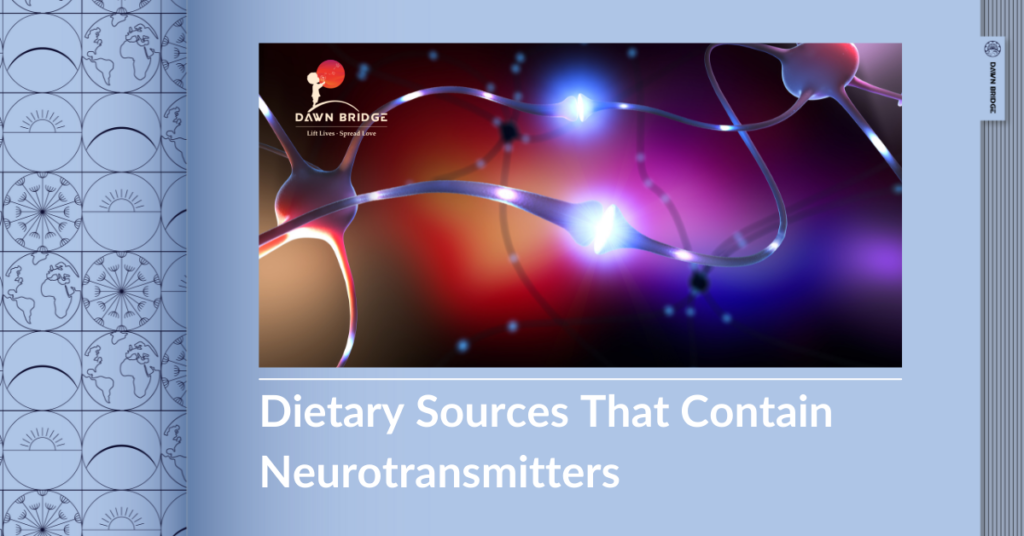Nutrients can be divided into two categories: macronutrients, and micronutrients. Nowadays, many studies illustrate an aspect of nutritional’s effects on the brain and provide the basis for new modes of therapy for patients with metabolic, neurologic or psychiatric diseases. Luckily, our natural food contains many essential nutrients that help in homeostasis in our bodies. For example, dietary neurotransmitters, these substances can either be naturally present, as part of essential metabolic processes and ecological interactions or derive from food technology processes.
Here is the list of dietary sources that contain neurotransmitters:
| Neurotransmitters | Functions | Dietary Sources | Related Disorders |
| Acetylcholine | It is a primary neurotransmitter at neuromuscular junctions, at synapses. It functions in the central and peripheral nervous systems. | – Pea – Spinach – Bitter – Orange – Wild Strawberry | – Alzheimer’s Disease – Parkinson’s Disease – Myasthenia Gravis |
| Dopamine | It plays an important role in reward and movement regulation in the brain. | – Banana – Avocado – Orange – Apple – Common Bean | – Parkinson’s Disease – Attention Deficit Hyperactivity Disorder (ADHD) – Addiction – Schizophrenia |
| Serotonin | It regulates mood, emotions, appetite and digestion | – Papaya – Pineapple – Pomegranate – Kiwi – Lettuce – Potato | – Depression – Bipolar Disorder – Post -Traumatic Stress Disorder – Bulimia – Obsessive-compulsive Disorder |
| Histamine | It involves inflammation and acts as a central mediator of itching. | – Anchovy – Sardine – Sausages – Dairy Products | – Tourette’s Syndrome – Ulcerative Colitis – Narcolepsy with Cataplexy |
| Glutamate | It is the primary excitatory neurotransmitter in the central nervous system. | – Cheese – Seafood – Seaweed – Mushrooms – Tomato | – Parkinson’s Disease – Multiple Sclerosis – Alzheimer’s Disease – Stroke – Amyotrophic Lateral Sclerosis (ALS) |
| GABA | It is a primary inhibitory neurotransmitter for the central nervous system(CNS). | – Soybean – Rice – Oat – Wheat – Barley – Chestnut | – Autism Spectrum Disorder (ASD) – Attention Deficit Hyperactivity Disorder (ADHD) – Temporal Lobe Epilepsy (TLE) – Parkinson’s Disease (PD) – Huntington’s Disease (HD) |
In Summary
Certainly, knowledge of these dietary neurotransmitters could be a valuable starting point for scientists who wish to investigate their potential effects on human health. Yet, accurate and professional patient education on dietary neurotransmitters is important for those who seek to use dietary neurotransmitters in their daily lives. This is because the data on the bioavailability of dietary neurotransmitters is scarce, so it is advisable to consult a medical professional before taking dietary neurotransmitters.
Reference
1.Briguglio, Matteo & Dell’Osso, Bernardo & Panzica, Giancarlo & Malgaroli, Antonio & Banfi, Giuseppe & Dina, Carlotta & Galentino, Roberta & Porta, Mauro. (2018). Dietary Neurotransmitters: A Narrative Review on Current Knowledge. Nutrients. 10. 591. 10.3390/nu10050591.
2. Fernstrom JD. Effects on the diet on brain neurotransmitters. Metabolism. 1977 Feb;26(2):207-23. DOI: 10.1016/0026-0495(77)90057-9. PMID: 13261.

